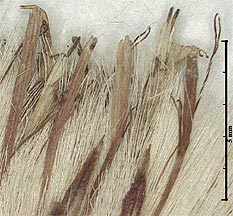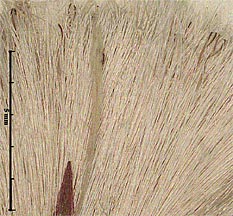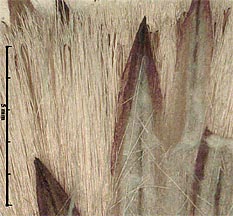




Trimorphic (ligulate), long–tubular and bimorphic specimens:
| month | total | clearly trimorphic |
trimorphic with reduced ligules |
long–tubular florets |
bimorphic | lacked florets |
|---|---|---|---|---|---|---|
| March | 7 | 6 | 0 | 1 | 0 | 0 |
| April | 4 | 3 | 0 | 1 | 0 | 0 |
| May | 1 | 1 | 0 | 0 | 0 | 1 |
| November | 1 | 0 | 1 | 0 | 0 | 0 |
C. texana (32 specimens)
| month | total | clearly trimorphic |
trimorphic with reduced ligules |
long–tubular florets |
bimorphic | lacked florets |
|---|---|---|---|---|---|---|
| March | 12 | 11 | 1 | 0 | 0 | 0 |
| April | 11 | 8 | 1 | 1 | 0 | 1 |
| August–November | 8 | 2 | 4 | 0 | 2 | 0 |
| January | 1 | 0 | 0 | 0 | 0 | 1 |
Compared with other Texas Asteraceae there are relatively few Chaptalia collections in TEX/LL (see table below); and over two thirds of these are from C. texana. I believe the primary reason for both these asymmetries is that a closed–head bloom, could perhaps be less obvious and even if noticed, less likely to be collected (considered not yet in flower, or not yet open). [For a recent example of this confusion, Summer 2011 issue of Wildflower (Magazine of the Lady Bird Johnson Wildflower Center has a photograph of a Chaptalia head in late anthesis labeled as 'bud;' p. 26.] The open early spring heads of C. texana exhibit a diurnal cycle, the head being fully open and typically erect or nearly so only during the middle of the day and closing & lowering in the evening. Further, not all C. carduacea heads produce exserted ligules in early spring, and those that do, have reduced ligules — a possible factor in the relatively small number of collections of this species as compared with C. texana.
Beginning with late spring and lasting through the winter both species enter a phase in which full ligules are not produced, and peripheral florets are often hidden within the involucre or long-tubular — i.e., morphologically similar to the inner eligulate florets but with a longer tube — or are absent (thus bimorphic). This phase is difficult to detect with pressed specimens
Unfortunately the collections do not allow determination of the closed/open head distinction, nor is any note of this found with the specimens. One specimen appears to have had an open head, and thus C. texana (Medina Co., E. R. Bogusch 807 [LL]), and only five others might have had an open head at the time of collection. The pressed specimens in general were not mounted in a manner that permits an analysis of the nodding behavior of Chaptalia species, sometimes used as a key feature. [For details of nodding based on fresh specimens.]
Number of specimen collections for various Central Texas Asteraceae in TEX/LL:
| Thymophylla pentachaeta | 322 | Liatris punctata var. mucronata | 77 |
|---|---|---|---|
| Ratibida columnifera | 306 | Grindelia lanceolata | 71 |
| Tetraneuris scaposa var. scaposa | 296 | Vernonia lindheimeri | 64 |
| Tetraneuris linearifolia | 243 | Chrysactinia mexicana | 62 |
| Engelmannia peristenia | 193 | Grindelia nuda | 60 |
| Cirsium texanum | 175 | Solidago nemoralis | 60 |
| Erigeron modestus | 168 | Tetragonotheca texana | 49 |
| Liatris punctata var. punctata | 151 | Dysodiopsis tagetoides | 44 |
| Centaurea americana | 136 | Chaptalia texana/carduacea | 44 |
| Chaetopappa asteroides var. asteroides | 108 | Brickellia cylindracea | 37 |
| Erigeron philadelphicus | 98 | Ageratina havanensis | 29 |
| Centaurea melitensis | 89 | Verbesina lindheimeri | 22 |